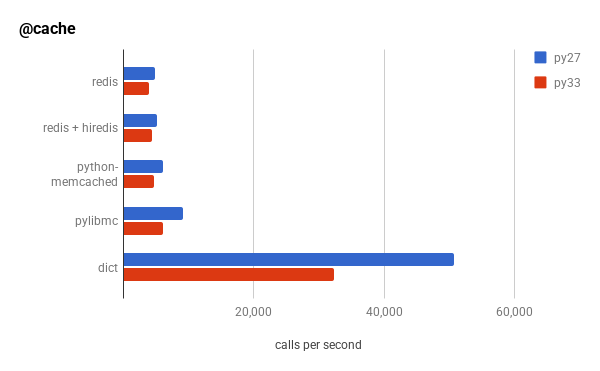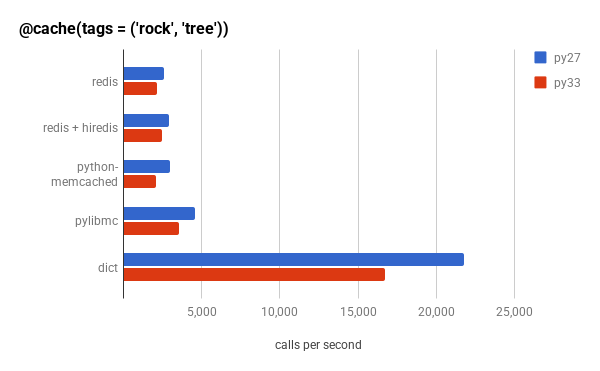Python caching library with tag-based invalidation and dogpile effect prevention
Project description



HermesCache
Hermes is a Python caching library. The requirements it was designed to fulfil:
Tag-based cache invalidation
Dogpile effect prevention
Thread-safety
Straightforward design
Simple, at the same time, flexible decorator as end-user API
Interface for implementing multiple backends
Implemented backends: redis, memcached, dict (no expiry).
Install
pip install HermesCacheMake sure desired backend client library is installed. See below.
Usage
The following demonstrates all end-user API.
import hermes.backend.redis
cache = hermes.Hermes(hermes.backend.redis.Backend, ttl = 600, host = 'localhost', db = 1)
@cache
def foo(a, b):
return a * b
class Example:
@cache(tags = ('math', 'power'), ttl = 1200)
def bar(self, a, b):
return a ** b
@cache(tags = ('math', 'avg'), key = lambda fn, *args, **kwargs: 'avg:{0}:{1}'.format(*args))
def baz(self, a, b):
return (a + b) / 2.0
print(foo(2, 333))
example = Example()
print(example.bar(2, 10))
print(example.baz(2, 10))
foo.invalidate(2, 333)
example.bar.invalidate(2, 10)
example.baz.invalidate(2, 10)
cache.clean(['math']) # invalidate entries tagged 'math'
cache.clean() # flush cacheFor advanced examples look in test suite.
Tagging cache entries
First let’s look how basic caching works.
import hermes.backend.dict
cache = hermes.Hermes(hermes.backend.dict.Backend)
@cache
def foo(a, b):
return a * b
foo(2, 2)
foo(2, 4)
print(cache.backend.dump())
# {
# 'cache:entry:foo:515d5cb1a98de31d': 8,
# 'cache:entry:foo:a1c97600eac6febb': 4
# ↓
# argument hash
# }Basically we have a key-value storage with O(1) complexity for set, get and delete. This means that the speed of operation is constant and irrelevant of number of items already stored. When a callable (function or method) is cached, the key is calculated per invocation from callable itself and passed arguments. Callable’s return value is saved to the key. Next invocation we can use the value from cache.
“There are only two hard problems in Computer Science: cache invalidation and naming things.” — Phil Karlton
So it comes in a complex application. There’s a case that certain group of methods operate the same data and it’s impractical to invalidate individual entries. In particular, it often happens when method returns complex values, spanning multiple entities. Cache tagging makes it possible to mark this group of method results with a tag and invalidate them all at once.
Here’s article by Eric Florenzano which explains the idea. Let’s look the code.
import hermes.backend.dict
cache = hermes.Hermes(hermes.backend.dict.Backend)
@cache(tags = ('tag1', 'tag2'))
def foo(a, b):
return a * b
foo(2, 2)
print(cache.backend.dump())
# {
# u'cache:tag:tag1': '0674536f9eb4eb19',
# u'cache:tag:tag2': 'db22b5ab2e504895',
# 'cache:entry:foo:a1c97600eac6febb:c1da510b3d42bad6': 4
# ↓
# tag hash
# }When we want to tag a cache entry, first we need to create the tag entries. Each tag is represented by its own entry. Value of tag entry is set to random value each time tag is created. Once all tags values exist, they are joined and hashed. Tag hash is added to cache entry key.
Once we want to invalidate tagged entries we just need to remove the tag entry. Without any of tag values tag hash was created with, it is impossible to construct the entry key so the tagged cache entries become inaccessible thus invalidated. As usually a feature built on-top of another feature adds complexity.
Performance. All operations become O(n) where n is number of entry tags. However since we can rarely need more than a few dozens of tags, practically it is still O(1). Tag entry operations are batched so the implications on number of network operations go as follow:
set – 3x backend calls (get + 2 * set) in worst case. Average is expected to be 2x when all used tag entries are created.
get – 2x backend calls.
delete – 2x backend calls.
Memory overhead consists of tag entries and stale cache entries. Demonstrated below.
import hermes.backend.dict
cache = hermes.Hermes(hermes.backend.dict.Backend)
@cache(tags = ('tag1', 'tag2'))
def foo(a, b):
return a * b
foo(2, 2)
print(cache.backend.dump())
# {
# u'cache:tag:tag1': '047820ac777abe8a',
# u'cache:tag:tag2': '126365ec7175e851',
# 'cache:entry:foo:a1c97600eac6febb:5cae80f5e7d58329': 4
# }
cache.clean(['tag1'])
foo(2, 2)
print(cache.backend.dump())
# {
# u'cache:tag:tag1': '66336fec212def16', ← recreated tag entry
# u'cache:tag:tag2': '126365ec7175e851',
# 'cache:entry:foo:a1c97600eac6febb:8e7e24cf70c1f0ab': 4,
# 'cache:entry:foo:a1c97600eac6febb:5cae80f5e7d58329': 4 ← garbage
# }So the TTLs should be chosen elaborately. With Redis backend it’s also recommended to set maxmemory-policy to volatile-lru.
Backend and client library
Supported dependencies are listed in tox.ini of the package. The way they put together is on project’s drone.io CI page.
Redis
hermes.backend.redis depends on redis. Optionally hiredis can be installed in addition to boost protocol parsing. However hiredis gives significant advantage on big bulk operations and in context of the package adds about 10%.
Memcached
hermes.backend.memcached depends either on pure-python python-memcached (python3-memcached as prior one is still broken on Python 3 with binary data) or on, libmemcached wrapper, pylibmc. pylibmc gives about 50% improvement.
Dict
hermes.backend.dict is neither complete backend nor it is designed for any distributed use. Original purpose was a development need and in fact it’s just a wrapper on Python dict. It doesn’t implement entry expiry and any memory limiting. Though it can be used in limited cases where cached entry size is a priori small and actual state is maintained only with manual invalidation.
Performance
Here are some clues about performance of backends and client libraries. It wasn’t an intension to provide some statistically significant performance estimation. These are just results from one of CI builds.


Reviewed implementations
Before I wrote the library I looked through the Cheese Shop for one that fits my needs. Unfortunately there was none, however some matched partially and were the inspiration in certain aspects:
- Pro:
clean end-user API
straightforward design
- Con:
no auto cache key calculation
no dogpile effect prevention
no cache entry tagging
fail with instance methods
- Pro:
mature
very well documented
prevents dogpile effect
- Con:
no cache entry tagging
complicated code-base
not concise end-user API
- Pro:
cache entry tagging
- Con:
designed for the news website scaffolding framework
thus bloat is all around
Project details
Release history Release notifications | RSS feed
Download files
Download the file for your platform. If you're not sure which to choose, learn more about installing packages.











